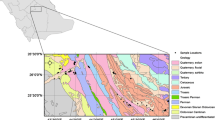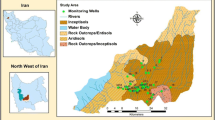Abstract
Hydrochemical processes have a great influence on the groundwater quality especially in arid regions where groundwater is the single most important source of water supply. The present study was carried out in the Wadi Ad Dawasir region of Saudi Arabia. The objective of this study was to determine the processes influencing the groundwater composition in the region by integrated hydrochemical and statistical assessment. Hydrochemical data from 140 groundwater samples were interpreted using hydrochemical and statistical techniques. Evaporation, mineral dissolution, reverse ion exchange, and chloride/nitrate contamination from irrigation return flows were the main geogenic and anthropogenic sources influencing the groundwater composition. Principal component analysis was carried out to determine the component showing the maximum variability in the data. Two principal components were extracted. The first principal component representing gypsum dissolution and anthropogenic pollution (chloride and nitrate pollution from agricultural farms) was more pronounced in the western part of the study area whereas the second principal component representing silicate weathering process was more dominant in the eastern part. Total dissolved solid was found to be the single most important hydrochemical parameter showing the maximum variation in the analyzed data set. This study demonstrates that the loadings of the individual hydrochemical parameters in the extracted principal component and the component scores of the individual samples for each extracted principal component can be effectively used for determining the hydrochemical processes influencing the groundwater chemistry in an area.














Similar content being viewed by others
References
Ahmed, A. A., Shabana, A. R., & Saleh, A. A. (2019). Using hydrochemical and isotopic data to determine sources of recharge and groundwater evolution in arid region from Eastern Desert, Egypt. Journal of African Earth Sciences, 151, 36–46.
Alabdula’aly, A. I., Al-Rehaili, A. M., Al-Zarah, A. I., & Khan, M. A. (2010). Assessment of nitrate concentration in groundwater in Saudi Arabia. Environmental Monitoring and Assessment, 161(1–4), 1–9.
Al-Faifi, H.J. (2005). Evaluation of groundwater resources in Wajid Aquifer in WadiDawasir area southern Saudi Arabia, using computer simulation. M.Sc. Thesis, King Saud University, Riyadh.
Al-Kahtani, S. H., & Ismaiel, S. M. (2010). Groundwater irrigation management in the Kingdom of Saudi Arabia: a case study of Al-Wajid aquifer (Vol. 7, pp. 54–65). J. US-China Public Admin.
Al-Omran, A. M., Aly, A. A., Al-Wabel, M. I., Sallam, A. S., & Al-Shayaa, M. S. (2016). Hydrochemical characterization of groundwater under agricultural land in arid environment: a case study of Al-Kharj, Saudi Arabia. Arabian Journal of Geosciences, 9(1), 68.
Al-Wabel, M. I., El-Saeid, M. H., Al-Turki, A. M., & Abdel-Nasser, G. (2011). Monitoring of pesticide residues in Saudi Arabia agricultural soils. Research Journal of Environmental Sciences, 5(3), 269–278.
Appelo, C. A. J., & Postma, D. (2005). Geochemistry, groundwater and pollution (2nd ed.). Rotterdam: Balkema.
Bro, R., & Smilde, A. K. (2014). Principal component analysis. Analytical Methods, 6(9), 2812–2831.
Chadha, D. K. (1999). A proposed new diagram for geochemical classification of natural waters and interpretation of chemical data. Hydrogeology Journal, 7(5), 431–439.
Chatfield, C., & Collins, A. (2018). Introduction to multivariate analysis. Boca Raton: Routledge.
Chen, H., Yan, M., Yang, X., Chen, Z., Wang, G., Schmidt-Vogt, D., Xu, Y., & Xu, J. (2012). Spatial distribution and temporal variation of high fluoride contents in groundwater and prevalence of fluorosis in humans in Yuanmou County, Southwest China. Journal of Hazardous Materials, 235, 201–209.
Climate-data.org. (2019). https://en.climate-data.org/asia/saudi-arabia/riyadh-region/wadi-ad-dawasir-935901/. Accessed March 28, 2019.
Corner, S. (2009). Choosing the right type of rotation in PCA and EFA. JALT Testing & Evaluation SIG Newsletter, 13(3), 20–25.
Dalin, C., Wada, Y., Kastner, T., & Puma, M. J. (2017). Groundwater depletion embedded in international food trade. Nature, 543(7647), 700–704.
El Alfy, M., Lashin, A., Abdalla, F., & Al-Bassam, A. (2017). Assessing the hydrogeochemical processes affecting groundwater pollution in arid areas using an integration of geochemical equilibrium and multivariate statistical techniques. Environmental Pollution, 229, 760–770.
Foster, S. S. D. (2001). The interdependence of groundwater and urbanisation in rapidly developing cities. Urban Water, 3(3), 185–192.
Gejl, R. N., Rygaard, M., Henriksen, H. J., Rasmussen, J., & Bjerg, P. L. (2019). Understanding the impacts of groundwater abstraction through long-term trends in water quality. Water Research, 156, 241–251.
Gubran, M., Ghrefat, H., Zaidi, F., & Shehata, M. (2019). Integration of hydrochemical, GIS, and remote-sensing data for assessment of shallow groundwater aquifers in Wadi Nisah, Central Saudi Arabia. Environmental Earth Sciences, 78(5), 161.
Iqbal, J., Nazzal, Y., Howari, F., Xavier, C., & Yousef, A. (2018). Hydrochemical processes determining the groundwater quality for irrigation use in an arid environment: the case of Liwa Aquifer, Abu Dhabi, United Arab Emirates. Groundwater for Sustainable Development, 7, 212–219.
Jankowski, J., & Acworth, R. I. (1997). Impact of debris-flow deposits on hydrogeochemical processes and the developement of dryland salinity in the Yass River catchment, New South Wales, Australia. Hydrogeology Journal, 5(4), 71–88.
Jiang, Y., Guo, H., Jia, Y., Cao, Y., & Hu, C. (2015). Principal component analysis and hierarchical cluster analyses of arsenic groundwater geochemistry in the Hetao basin, Inner Mongolia. Chemie der Erde-Geochemistry, 75(2), 197–205.
Karroum, M., Elgettafi, M., Elmandour, A., Wilske, C., Himi, M., & Casas, A. (2017). Geochemical processes controlling groundwater quality under semi arid environment: a case study in central Morocco. Science of the Total Environment, 609, 1140–1151.
Kawo, N. S., & Karuppannan, S. (2018). Groundwater quality assessment using water quality index and GIS technique in Modjo River Basin, central Ethiopia. Journal of African Earth Sciences, 147, 300–311.
Kumar, S., Venkatesh, A. S., Singh, R., Udayabhanu, G., & Saha, D. (2018). Geochemical signatures and isotopic systematics constraining dynamics of fluoride contamination in groundwater across Jamui District, Indo-Gangetic alluvial plains, India. Chemosphere, 205, 493–505.
Lakshmanan, E., Kannan, R., & Kumar, M. S. (2003). Major ion chemistry and identification of hydrogeochemical processes of ground water in a part of Kancheepuram District, Tamil Nadu, India. Environmental Geosciences, 10(4), 157–166.
Le Nindre, Y.-M., Manivit, J. and Vaslet, D. (1987). Histoire géologique de la Bordure occidentale de la Plate-forme Arabe du Paléozoïque inférieur au Jurassique supérieur. Thèse de Doctorat de l’Université de Paris 6, 4 vol., 1113 p. dactyl. + Annexes.
Le Nindre, Y.-M., Manivit, J. and Vaslet, D. (1990). Le Jurassique d’Arabie centrale, Histoire géologique de la bordure occidentale de la plate-forme Arabe, vol. 2. Document du Bureau de Recherches Géologiques et Minières, v. 192, 290 p.
Li, J., Liang, X., Zhang, Y., Liu, Y., Chen, N., Abubakari, A., & Jin, M. (2017). Salinization of porewater in a multiple aquitard-aquifer system in Jiangsu coastal plain, China. Hydrogeology Journal, 25(8), 2377–2390.
Manivit, J., Pellaton, C., Vaslet, D., Le Nindre, Y.-M. Brosse, J.-M., Breton, J.-P. and Fourniguet, J. (1986). Geological map of the Darma’ quadrangle, sheet 24 H, Kingdom of Saudi Arabia (with text). Saudi Arabia Deputy Ministry of Mineral Resources, Geoscience Map GM-101, Scale 1:250,000.
Masoud, M. H., Basahi, J. M., & Rajmohan, N. (2018). Impact of flash flood recharge on groundwater quality and its suitability in the Wadi Baysh Basin, Western Saudi Arabia: an integrated approach. Environmental Earth Sciences, 77(10), 395.
Matter, A., Mahjoub, A., Neubert, E., Preusser, F., Schwalb, A., Szidat, S., & Wulf, G. (2016). Reactivation of the Pleistocene trans-Arabian Wadi ad Dawasir fluvial system (Saudi Arabia) during the Holocene humid phase. Geomorphology, 270, 88–101.
MoWE (2010). Detailed water resources studies of Wajid and overlying aquifers. Ministry of Water and Electricity. Kingdom of Saudi Arabia. Unpublished report
Nazzal, Y., Al-Arifi, N., Zumlot, T., & Kishawy, H. (2014). Statistical characterization of the hydrochemical data’s of groundwater in the arid land of Wadi AdDawasir area, Saudi Arabia: a probabilistic assessment. Geologia Croatica, 67(3), 207–216.
Olive, D.J. (2017). Principal component analysis. In Robust multivariate analysis (pp. 189–217). Cham: Springer.
Panno, S. V., Hackley, K. C., Hwang, H. H., Greenberg, S. E., Krapac, I. G., Landsberger, S., & O’Kelly, D. J. (2006). Characterization and identification of Na-Cl sources in ground water. Groundwater, 44(2), 176–187.
Parkhurst, D.L. and Appelo, C.A.J. (2013). Description of input and examples for PHREEQC version 3: a computer program for speciation, batch-reaction, one-dimensional transport, and inverse geochemical calculations (No. 6-A43). US Geological Survey.
Qian, J., Wang, L., Ma, L., Lu, Y., Zhao, W., & Zhang, Y. (2016). Multivariate statistical analysis of water chemistry in evaluating groundwater geochemical evolution and aquifer connectivity near a large coal mine, Anhui, China. Environmental Earth Sciences, 75(9), 747.
Rajmohan, N., & Elango, L. (2004). Identification and evolution of hydrogeochemical processes in the groundwater environment in an area of the Palar and Cheyyar river basins, Southern India. Environmental Geology, 46(1), 47–61.
Ringnér, M. (2008). What is principal component analysis? Nature Biotechnology, 26(3), 303–304.
Schoeller, H. (1977). Geochemistry of groundwater. In R. H. Brown, A. A. Konoplyantsev, J. Ineson, & V. S. Kovalevsky (Eds), Groundwater studies—an international guide for research and practice (pp. 1–18). Paris: UNESCO.
Singh, P., Asthana, H., Rena, V., Kumar, P., Kushawaha, J., & Mukherjee, S. (2018). Hydrogeochemical processes controlling fluoride enrichment within alluvial and hard rock aquifers in a part of a semi-arid region of Northern India. Environmental Earth Sciences, 77(12), 475.
Song, Y., Xie, S., Zhang, Y., Zeng, L., Salmon, L. G., & Zheng, M. (2006). Source apportionment of PM2.5 in Beijing using principal component analysis/absolute principal component scores and UNMIX. Science of the Total Environment, 372(1), 278–286.
Sowers, J., Vengosh, A., & Weinthal, E. (2011). Climate change, water resources, and the politics of adaptation in the Middle East and North Africa. Climatic Change, 104(3–4), 599–627.
Subramani, T., Rajmohan, N., & Elango, L. (2010). Groundwater geochemistry and identification of hydrogeochemical processes in a hard rock region, Southern India. Environmental Monitoring and Assessment, 162(1–4), 123–137.
Thakur, T., Rishi, M. S., Naik, P. K. & Sharma, P. (2016). Elucidating hydrochemical properties of groundwater for drinking and agriculture in parts of Punjab, India. Environmental Earth Sciences, 75(6), 467.
Ukpai, S. N., & Okogbue, C. O. (2017). Geophysical, geochemical and hydrological analyses of water-resource vulnerability to salinization: case of the Uburu-Okposi salt lakes and environs, southeast Nigeria. Hydrogeology Journal, 25(7), 1997–2014.
Vaslet, D., Delfour, J., Manivit, J., Le Nindre, Y.-M., Brosse, J.-M. and Fourniguet J. (1983). Geological map of the Wadi ar Rayn quadrangle, sheet 23 H, Kingdom of Saudi Arabia (with text). Saudi Arabia Deputy Ministry of Mineral Resources, Geoscience Map GM-63, Scale 1: 250,000.
Wang, H., Jiang, X. W., Wan, L., Han, G., & Guo, H. (2015). Hydrogeochemical characterization of groundwater flow systems in the discharge area of a river basin. Journal of Hydrology, 527, 433–441.
Whittemore, D. O., Butler, J. J., Jr., & Wilson, B. B. (2016). Assessing the major drivers of water-level declines: new insights into the future of heavily stressed aquifers. Hydrological Sciences Journal, 61(1), 134–145.
Winston, R.B. (2000). Graphical user interface for MODFLOW, version 4: U.S. Geological Survey Open-File Report 00-315, 27 p.
Zaidi, F. K., Nazzal, Y., Jafri, M. K., Naeem, M., & Ahmed, I. (2015). Reverse ion exchange as a major process controlling the groundwater chemistry in an arid environment: a case study from northwestern Saudi Arabia. Environmental Monitoring and Assessment, 187(10), 607.
Zaidi, F. K., Mogren, S., Mukhopadhyay, M., & Ibrahim, E. (2016). Evaluation of groundwater chemistry and its impact on drinking and irrigation water quality in the eastern part of the Central Arabian graben and trough system, Saudi Arabia. Journal of African Earth Sciences, 120, 208–219.
Funding
The authors extend their appreciation to the Deanship of Scientific Research at King Saud University for funding this work through research group number (RG-1438-023).
Author information
Authors and Affiliations
Corresponding author
Ethics declarations
Conflict of interest
The authors declare that they have no conflict of interest.
Additional information
Publisher’s note
Springer Nature remains neutral with regard to jurisdictional claims in published maps and institutional affiliations.
Rights and permissions
About this article
Cite this article
Zaidi, F.K., Salman, A., Hag-Elsafi, S. et al. Assessment of hydrological processes operating in a multi-layered sedimentary aquifer system in Saudi Arabia using integrated chemical and statistical approach. Environ Monit Assess 191, 460 (2019). https://doi.org/10.1007/s10661-019-7597-7
Received:
Accepted:
Published:
DOI: https://doi.org/10.1007/s10661-019-7597-7




